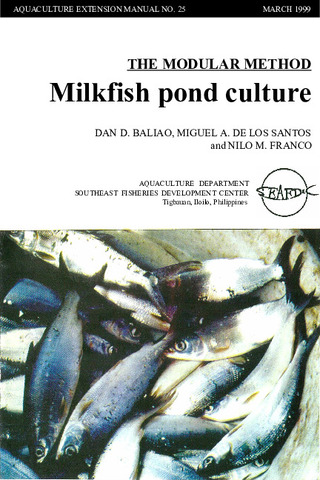Yolk resorption, onset of feeding and survival potential of larvae of three tropical marine fish species reared in the hatchery
- Global styles
- MLA
- Vancouver
- Elsevier - Harvard
- APA
- Help

View/
Date
1986Author
Page views
3,723ASFA keyword
AGROVOC keyword
Taxonomic term
Metadata
Show full item record
Share
Abstract
This paper provides basic early life-history information on milkfish (Chanos chanos), seabass (Lates calcarifer) and rabbitfish (Siganus guttatus) which may explain in part the observed differences in their survival performance in the hatchery. Egg size, larval size, amount of yolk and oil reserves and mouth size are all greater in milkfish than in seabass, and greater in the latter than in rabbitfish. During the first 24 h after hatching, rabbitfish larvae grow much faster than milkfish and seabass larvae at similar ambient temperatures (range 26°–30°C, mean about 28°C). The eyes become fully pigmented and the mouths open earlier in seabass and rabbitfish (32–36 h from hatching) than in milkfish (54 h). Seabass larvae learn to feed the earliest. Yolk is completely resorbed at 120 h from hatching in milkfish, and yolk plus oil at 120 h in seabass and 72 h in rabbitfish at 26° to 30°C. Milkfish and seabass larvae have more time than rabbitfish to initiate external feeding before the endogenous reserves are completely resorbed. Delayed feeding experiments showed that 50% of unfed milkfish larvae die at 78 h and all die at 150 h from hatching. Milkfish larvae fed within 54 to 78 h after hatching had improved survival times: 50% mortality occurred at 96 to 120 h, and 10 to 13% survived beyond 150 h. Unfed seabass larvae all died at 144 h, while 6 to 13% of those fed within 32 to 56 h after hatching survived beyond 144 h and well into the subsequent weeks. Unfed rabbitfish larvae all died at 88 h, while 7 to 12% of those fed within 32 to 56 h after hatching survived beyond 88 h. A delay in initial feeding of more than 24 h after eye pigmentation and opening of the mouth may be fatal for all three species.
Description
Contribution No. 167 of the Aquaculture Department, SEAFDEC.
Suggested Citation
Bagarinao, T. (1986). Yolk resorption, onset of feeding and survival potential of larvae of three tropical marine fish species reared in the hatchery. Marine Biology , 91(4), 449-459. https://doi.org/10.1007/BF00392595
Type
ArticleISSN
0025-3162Collections
- Journal Articles [1256]
Related items
Showing items related by title, author, creator and subject.
-
Series: Aquaculture extension manual; No. 25
The modular method: Milkfish pond culture
Baliao, Dan D.; de los Santos, Miguel A.; Franco, Nilo M. (Aquaculture Department, Southeast Asian Fisheries Development Center, 1999)The modular method of milkfish culture (Chanos chanos) described in the manual is an improvement over the traditional extensive method. The manual is intended for the use of fish farmers and aquaculturists, extensionists, ... -
Evaluation of organic and inorganic fertilizers in brackishwater milkfish ponds
Bombeo-Tuburan, Isidra; Agbayani, Renato F.; Subosa, Precilla F. (Elsevier, 1989)The study was conducted in twelve 144-m2 ponds to evaluate the effect of different organic and inorganic fertilizers on the growth, survival, gross production, and profitability of marketable milkfish. The ... -
Milkfish breeding and hatchery technology at SEAFDEC/AQD
Unknown author (Aquaculture Department, Southeast Asian Fisheries Development Center, 1999)Describes the techniques already adopted by the private sector: broodstock management, broodstock diet, commercial fry production, live transport, and larval diet. A list of AQD research publications on milkfish is included.






